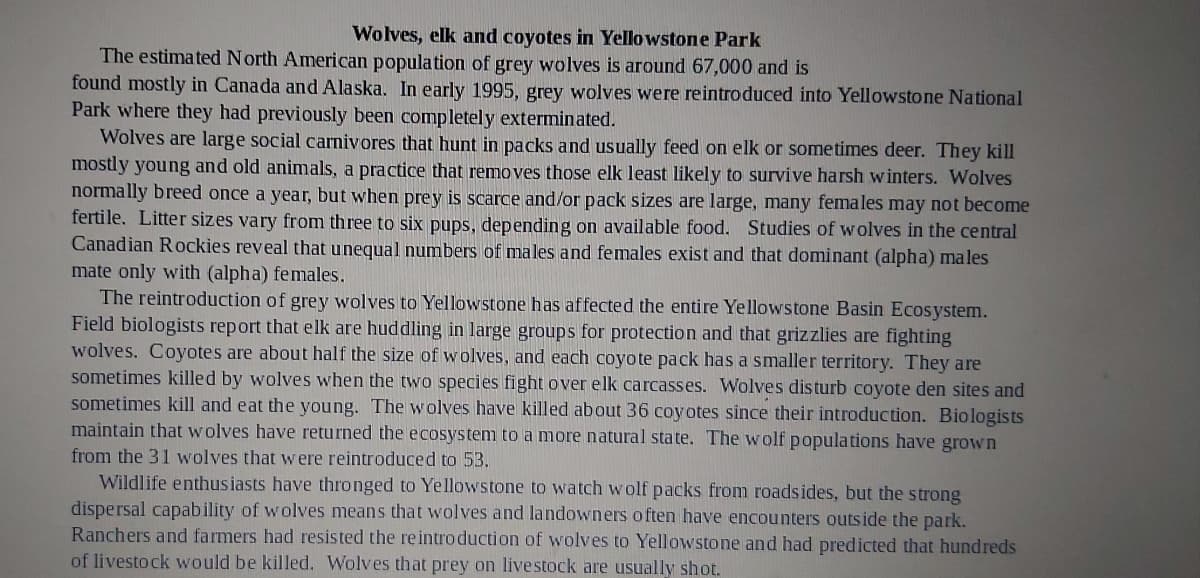Classify the type of reproductive strategy exhibited by wolves and provide two pieces of support from the reading . You should use those supports to back up your choice , that is , how did these 2 pieces of support lead to your answer
Classify the type of reproductive strategy exhibited by wolves and provide two pieces of support from the reading . You should use those supports to back up your choice , that is , how did these 2 pieces of support lead to your answer
Concepts of Biology
1st Edition
ISBN:9781938168116
Author:Samantha Fowler, Rebecca Roush, James Wise
Publisher:Samantha Fowler, Rebecca Roush, James Wise
Chapter19: Population And Community Ecology
Section: Chapter Questions
Problem 2ACQ: Figure 19.6 If the major food source of seals declines due to pollution or overfishing, which of the...
Related questions
Question
Classify the type of reproductive strategy exhibited by wolves and provide two pieces of support from the reading . You should use those supports to back up your choice , that is , how did these 2 pieces of support lead to your answer

Transcribed Image Text:Wolves, elk and coyotes in Yellowstone Park
The estimated North American population of grey wolves is around 67,000 and is
found mostly in Canada and Alaska. In early 1995, grey wolves were reintroduced into Yellowstone National
Park where they had previously been completely exterminated.
Wolves are large social carnivores that hunt in packs and usually feed on elk or sometimes deer. They kill
mostly young and old animals, a practice that removes those elk least likely to survive harsh winters. Wolves
normally breed once a year, but when prey is scarce and/or pack sizes are large, many females may not become
fertile. Litter sizes vary from three to six pups, depending on available food. Studies of wolves in the central
Canadian Rockies reveal that unequal numbers of males and females exist and that dominant (alpha) males
mate only with (alpha) females.
The reintroduction of grey wolves to Yellowstone has affected the entire Yellowstone Basin Ecosystem.
Field biologists report that elk are huddling in large groups for protection and that grizzlies are fighting
wolves. Coyotes are about half the size of wolves, and each coyote pack has a smaller territory. They are
sometimes killed by wolves when the two species fight over elk carcasses. Wolves disturb coyote den sites and
sometimes kill and eat the young. The wolves have killed about 36 coyotes since their introduction. Biologists
maintain that wolves have returned the ecosystem to a more natural state. The wolf populations have grown
from the 31 wolves that w ere reintroduced to 53.
Wildlife enthusiasts have thronged to Yellowstone to watch wolf packs from roadsides, but the strong
dispersal capability of wolves means that wolves and landowners often have encounters outside the park.
Ranchers and farmers had resisted the reintro duction of wolves to Yellowstone and had predicted that hundreds
of livesto ck would be killed. Wolves that prey on livestock are usually shot.
Expert Solution
This question has been solved!
Explore an expertly crafted, step-by-step solution for a thorough understanding of key concepts.
Step by step
Solved in 2 steps

Knowledge Booster
Learn more about
Need a deep-dive on the concept behind this application? Look no further. Learn more about this topic, biology and related others by exploring similar questions and additional content below.Recommended textbooks for you

Concepts of Biology
Biology
ISBN:
9781938168116
Author:
Samantha Fowler, Rebecca Roush, James Wise
Publisher:
OpenStax College


Biology Today and Tomorrow without Physiology (Mi…
Biology
ISBN:
9781305117396
Author:
Cecie Starr, Christine Evers, Lisa Starr
Publisher:
Cengage Learning

Concepts of Biology
Biology
ISBN:
9781938168116
Author:
Samantha Fowler, Rebecca Roush, James Wise
Publisher:
OpenStax College


Biology Today and Tomorrow without Physiology (Mi…
Biology
ISBN:
9781305117396
Author:
Cecie Starr, Christine Evers, Lisa Starr
Publisher:
Cengage Learning